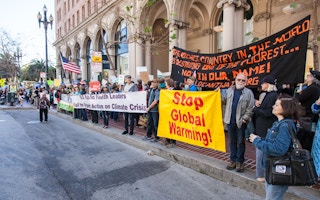“Climate change is nonsense.” When De Telegraaf – the largest newspaper of the Netherlands – asked its readership last month to either agree or disagree with this statement in its daily readership poll, the result: 61 per cent agreed. Eight out of ten respondents to the poll even said not to worry about the possible consequences of climate change.
These results are similar to a recent Gallup poll in the United States that ranked climate change, along with the quality of the environment, near the bottom of a list of 15 issues that Americans are worried about. Only 24% admitted that they worry about it a great deal, while twice as many said they worry a great deal about the size and power of the federal government.
Nearly 60 years since the Gilbert Plass 1956 study The Carbon Dioxide Theory of Climatic Change accurately predicted the sensitivity of the Earth’s climate, many people are still not convinced that it is our unabated increase in CO2 emissions that is heating the planet and causing climate change.
The Dutch football coach Louis van Gaal once proclaimed at a press conference: “Am I the one who’s so smart, or are you so stupid?” It is tempting to bang your head on the table on hearing such numbers and move on because, hey, we are the ones who are right!
But perhaps it is worth investigating why there are still so many people who don’t believe that climate change is real as that may also explain inaction from politicians. The scientific proof seems overwhelming. Two weeks before De Telegraaf conducted its poll, a survey of over 12,000 peer-reviewed climate science papers found that 97% of scientists agree that climate change is real and is caused by humans.
But would this actually change the thinking and behaviour of the 61 per cent who said that they think climate change is nonsense?
The doomsday scenarios, the overly scientific way of describing the issue and a lack of consensus in the climate change message are not helping.
The way climate change has been and is being communicated – the IPCC definition of climate change is no less than 123 words – is failing to convince the sceptics. And in Western democracies, politicians usually don’t act unless a sizeable majority backs them. This is, after all, how democracy works.
Perhaps the answer lies in neuroscience; what happens in our brain when we receive information? Professor Richard Boyatzis, of Case Western University in Ohio, has conducted extensive research in how the brain responds to negative and positive messages.
His research suggests that when hearing a negative message, parts of the brain are activated that are associated with narrowing attention, less compassion and more negative emotions. Arousal of strong negative emotions stimulates a part of our brain that invokes cognitive, emotional and perceptual impairment.
At the same time, positive emotions activate the part of our brain that stimulates well-being, better immune system functioning, and cognitive, emotional, and perceptual openness, and increases creativity.
Convincing people that climate change is real is perhaps a start, but it is not enough. Collective and decisive action is required, not only from governments and companies but also from consumers. To effect real change, we need a shift in behaviour.
People need to be inspired as well as convinced. To achieve that, perhaps the best brains in the marketing and advertising industry could figure out a way of reaching the climate sceptics in a positive, hopeful reflection of a desired future – a future without floods, severe weather events, rising food prices and other consequences of climate change.
Those messages should not be about the measures that need to be implemented or the metrics that need to be achieved, such as a certain-percentage cut in CO2 emissions. Research from Boyatzis has shown this confuses people and results in them shutting down cognitively, emotionally and perceptually.
We need to figure out a way to discuss the overall purpose, not the individual targets, of fighting climate change. The politicians can discuss the numbers.
Remember the Kyoto protocol? Well, CO2 emissions have increased 50 per cent since then. Yet, we have failed to act.
We are the first generation to feel the full impact of climate change and the last generation that can do something about it. It is time for the best brains in the marketing, advertising, branding and communications industries to come together and develop an inspiring message, less dominated by science, on the greatest challenge we have ever faced.
Herman Betten is Communications Director for Royal DSM. This post originally appeared on the World Economic Forum blog.











